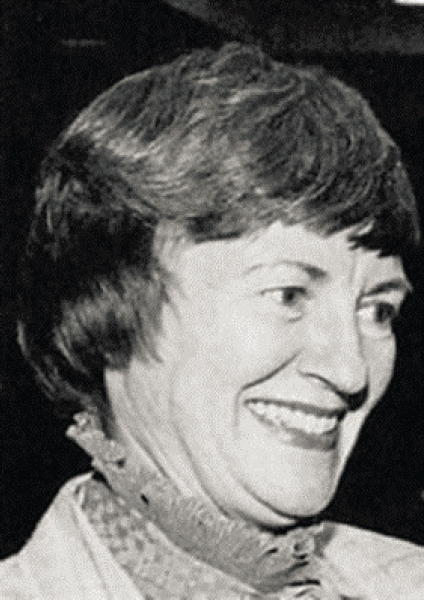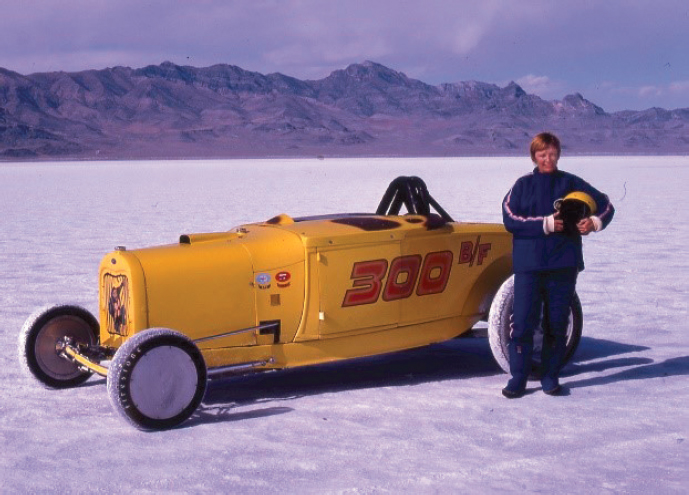ROBERTA J. NICHOLS
1931–2005
Elected in 1997
“For the development of alternative fuels and flexible-fuel vehicles.”
BY WALLACE R. WADE, CHARLES K. WESTBROOK, RICHARD J. WINELAND, JOHN J. KOSZEWNIK, AND KATHLEEN A. McDONALD
ROBERTA JEAN NICHOLS, a pioneering aerospace and automotive engineer who led the development of alternative fuel vehicles for Ford Motor Company, died April 3, 2005, of leukemia at her home in Plymouth, Michigan, at the age of 73. Born November 29, 1931, to Robert and Winifred Hilts in Venice, California, Roberta grew up following her father to junkyards to salvage parts, learning to weld, and helping to work on his vintage cars. Her professional career was inspired by her father, who was a Douglas Aircraft Company engineer.
She graduated from Santa Monica High School in 1949. She earned a bachelor’s degree in physics from the University of California, Los Angeles in 1968, and then her master’s (1975) and doctoral (1979) degrees in environmental engineering from the University of Southern California. She attained all three of her degrees while working full time and raising a family.
Roberta’s first job in 1957 was as a mathematician at Douglas Aircraft Company. In 1958 she joined Space Technology Laboratory in Redondo Beach, CA, one of the prime contractors for the Air Force Space Program, and worked on computer technology.
When Congress formed the Aerospace Corporation in El Segundo, CA, in 1960, she was transferred there to work as a
data analyst and researcher. The corporation was established as a nonprofit organization to aid the Air Force in “applying the full resources of modern science and technology to the problem of achieving continuing advances in ballistic missiles and military space systems.” Over the next 19 years she worked on weapons systems and air quality controls.
Roberta often said, “My first love is the internal combustion engine.” She was initially interested in what she called “funny fuels,” not to reduce air pollution but to enhance the performance of internal combustion engines in the boats and cars that she raced. She raced blown-fuel hydroplanes at the quarter-mile boat drag races and held the women’s world record, 131 mph, from 1966 to 1969. From 1964 to 1972 she headed the board of directors of the National Drag Boat Association.
By 1972 Roberta decided to concentrate on racing vintage cars, especially a 1954 Mercedes-Benz 300-SL Gullwing—once owned by actress Jeanne Crain—that she bought in 1968. She restored the vintage Gullwing and raced it at Laguna Seca and other venues. She even raced a methanol-powered 1929 Model A Ford and reached her fastest speed of 190 mph at the Bonneville Salt Flats in Utah.
In 1978 Roberta formed California’s synthetic fuel office and personally converted a Ford Pinto station wagon to run on methanol. A year later, a Ford Motor Company official learned of her work and hired her to be the driving force for alternative fuels at Ford. Through her initiative, the company delivered its first fleet of methanol vehicles to California in 1981. She worked tirelessly on methanol, ethanol, natural gas, and electric vehicles, including experiments with hybrid gasoline-electric vehicles. She made frequent trips to Washington, DC, to show alternative fuel cars to members of Congress.
She worked at Ford from 1979 until her retirement in 1995, first as a principal research engineer, then as manager of alternative fuels, and later as manager of electric vehicle external affairs, strategy, and planning. Reflecting on her Ford career, she simply said, “Sustainable, clean energy became my passion.”
Roberta worked tirelessly to solve the so-called “chicken and egg” dilemma as it related to alternative fuel vehicles and the infrastructure needed for alternative fuels: Vehicle manufacturers could not justify producing vehicles capable of operating on alternative fuels if they could not be refueled, and energy companies could not justify developing the infrastructure for alternative fuels without a sufficient number of vehicles to use the fuel. As a breakthrough solution, Ford began development of a dual- or flexible-fuel vehicle (FFV) in 1982 and, between 1985 and 1992, built and delivered over 700 experimental FFVs to California and Canada. They could operate on either methanol or gasoline or any mixture of the two fuels, with only one fuel system.
The key incentive that initiated widespread adoption of FFVs was the Alternative Motor Fuels Act of 1988, which Roberta was instrumental in promoting. The act provided significant Corporate Average Fuel Economy (CAFE) credits for the manufacture of FFVs that could operate on either an alternative fuel or gasoline. These FFVs would be assigned a higher fuel economy value for CAFE purposes in recognition of the fact that they could displace gasoline use and thus reduce dependence on foreign oil. The special CAFE calculation encouraged the production of FFVs by helping automobile manufacturers meet the CAFE standards, and led to widespread adoption of FFV technology and greater demand for ethanol made from corn and other biomass (renewable organic material from plants and animals). This in turn provided an expanded market for US farmers. Thus began the movement toward ethanol as the primary source of alternative fuel, the growth of a vehicle fleet capable of operating on alternative fuel, and the development of an infrastructure to support the fleet.
In model year 1991 Ford introduced its methanol FFV Taurus, which was produced until model year 1998. In model year 1994 the company added the ethanol FFV Taurus. Since these beginnings, FFV technology has been used in millions of production Ford vehicles. Other US manufacturers followed and by 2015 more than 80 different vehicle models with FFV
capability were offered in the United States. Within 5 years 22 million FFVs were on the road.
The Department of Energy reports that there are now 3300 stations in 42 states dispensing ethanol (E85) fuel, up from only 126 stations in 2002. Since ethanol is a domestic energy source in the United States, it helped to reduce reliance on imported oil. The E85 used in FFVs consists of 85 percent ethanol and 15 percent gasoline. Roberta’s research showed that the 15 percent gasoline provided adequate fuel vaporization for cold weather starting. Additionally, an E85 flame is easily visible in daylight for safety purposes.
Because of the corrosive nature of ethanol, which contains oxygen, Roberta oversaw the development of ethanol-compatible materials for FFV fuel system components (e.g., lines, hoses, gaskets, valves, fuel pumps, fuel injectors, and fuel tanks). As a result, these materials are now commonly used across the industry as the ethanol content in most gasolines has increased to 10 percent.
Roberta authored or coauthored over 60 publications and held three patents for the FFV, with an engine capable of using 100 percent gasoline, alcohol, or any mixture of both without any special action by the driver. The patents describe methods for (i) determining the desired air-to-fuel ratio for a mixture of two different fuels, such as gasoline and ethanol, with different stoichiometric, or chemically correct, air-to-fuel ratios; and (ii) a method for controlling the amount of spark advance for a mixture of two different fuels with different volatility and volumetric energy content. These methods were programmed in Ford’s EEC IV on-board engine computer so that the process was entirely automatic. Roberta was also instrumental in introducing the “FlexFuel E85 Ethanol” badge that was used on Ford as well as General Motors vehicles.
She also supported Ford’s worldwide alternate fuel vehicle programs. She served as an alternative fuel consultant to India at the request of the National Science Foundation and the United Nations in 1984.
Most notable is her work that supported Ford’s transition to ethanol fuels in Brazil. Because Brazil did not have
any domestic petroleum production, all of the fuel needed to accommodate the country’s growing transportation demand was imported. By using excess sugar cane production to make ethanol, Brazil could “home grow” most of the fuel needed to replace imported gasoline. Roberta’s ethanol engine research was instrumental in greatly improving the drivability, performance, and emissions of Ford’s Brazilian vehicles operating on ethanol. These improvements resulted in high customer satisfaction with ethanol-fueled vehicles.
As an accomplished veteran of boat and vintage car racing, in 1994 Roberta drove Ford’s small electric Ecostar delivery van in the 600-mile American Tour de Sol, the world’s largest electric and solar vehicle road rally; she finished second, behind another Ecostar. With a sodium-sulfur battery storing energy for a 75 horsepower (56 kW) electric motor, the Ecostar introduced the road-and-leaf logo now used on a number of Ford products to represent the company’s environmental commitment and alternative fuel leadership.
One of the authors (CKW, NAE 2017) was an enthusiastic and appreciative beneficiary of Roberta’s research. As he studied the hydrocarbon fuel molecules with the simplest possible structures, methane and methanol, to understand variations in engine performance using different fuels (among other things), he found that everywhere he looked, all the best work on methanol was done by R.J. Nichols. After several years, he was pleased to discover that this pioneering researcher was Dr. Roberta J. Nichols at Ford Motor Company.
She became well known and honored for her work. She was elected a member of the National Academy of Engineering in 1997—at the time one of only 37 women elected since its formation in 1964. She was the first woman to be elected a fellow of the Society of Automotive Engineers and one of only 270 fellows among the organization’s 80,000 members worldwide. She was also a fellow of the Society of Women Engineers (SWE) and a member of the American Society of Mechanical Engineers. Her awards include the SWE National Achievement Award (1988) and the Gene Ecklund Award from the Department of Energy (1996). In 1989 the California South Coast Air Quality
Management District selected Roberta to receive one of its first Clean Air Awards for her work with alternative fuels.
Roberta was a founding member of the advisory board for the College of Engineering – Center for Environmental Research and Technology (CE-CERT) at the University of California Riverside (UCR). Her devotion to CE-CERT and the UCR students continues through her generous creation of an endowed scholarship at UCR to encourage women in mechanical engineering. “I just grew up not knowing that girls weren’t supposed to like to do those kinds of things,” she told Woman Engineer magazine in 1992, after she had become a role model inspiring young women to go into her male-dominated profession. “As soon as I start talking to people about engines, they know I really do know what I’m talking about. It doesn’t matter anymore that I’m a woman.”
Her expertise was also recognized in appointments to National Academies committees to Review the Research Program of the Partnership for a New Generation of Vehicles (1999–2002), to Review the R&D Strategy for Biomass-Derived Ethanol and Biodiesel Transportation Fuels (1998–99), on the Advanced Automotive Technologies Plan (1997–98), and for a Review of the National Automated Highway System Consortium Research Program (1997–98). In addition, she served on the Charles Stark Draper Prize Committee (2000–02).
In a speech to SWE in March 2005, Roberta said, “Not all of us get to realize our dreams, but it is important to have them and never give up trying to attain them. It is amazing what can happen when you want something bad enough.” That was truly reflective of how she lived her life. No challenge was too small, no goal too large. She hoped that every young person, male or female, who heard her story would be inspired to pursue a career in engineering.
Roberta’s husband of 30 years (they married in 1974), Lynn Yakel, died July 27, 2008. She is survived by her daughter Kathleen McDonald, stepsons David Yakel and Dennis Yakel, and four grandchildren. She was preceded in death by her first husband (1948–59), William McDonald, and their son Robert McDonald. She was married to J.E. Nichols from 1960 to 1973.










